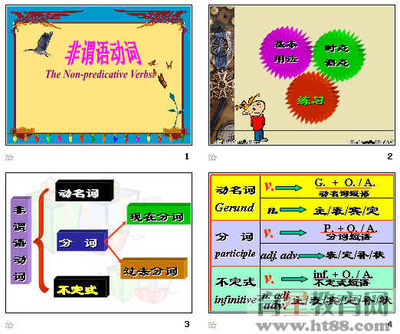非谓语动词
在句子中充当除谓语以外的句子成分的动词形式叫做非谓语动词。非谓语动词分为三种形式:不定式,动名词和分词(分词包括现在分词和过去分词)。
1)不定式
时态语态 主动 被动
一般式 to do to be done
完成式 to have done to have been done
2)动名词
时态语态 主动 被动
一般式 doing being done
完成式 having done having been done
3)分词
时态语态 主动 被动
一般式 doing being done
完成式 having done having been done
否定形式: not +不定式, not + 动名词, not + 现在分词
一、不定式
(一)不定式的常考形式
1. 一般形式:He decided to work harder in order to catch up with the others.
被动形式:He preferred to be assigned some heavier work to do.
语法功能:表示与谓语动词同步发生
2. 完成形式:He pretended not to have seen me.
被动形式:The book is said to have been translated into many languages.
语法功能:表示发生在谓语动词之前
(二)不定式常考的考点
1. 不定式做定语----将要发生
2. 不定式做状语----目的
3. 不定式充当名词功能---To see is to believe.
(三)不定式的省略
1. 感官动词 see, watch, observe, notice, look at, hear, listen to, smell, taste, feel
+ do 表示动作的完整性,真实性
+ doing 表示动作的连续性,进行性
I saw him work in the garden yesterday.
昨天我看见他在花园里干活了。(强调“我看见了”这个事实)
I saw him working in the garden yesterday.
昨天我见他正在花园里干活。(强调“我见他正干活”这个动作)
感官动词后面接形容词而不是副词:The cake tastes good; It feels comfortable.
(2) help help sb do help sb to do help do help to do
(四)有些动词后只跟不定式如
want,wish,hope,manage,promise,refuse,pretend,plan, offer,decide,agree,expect, allow sb to do, cause sb to do , permit sb to do, enable sb to do, love to do, warn sb to do, be able to do
begin to do, start to do
(五) 有的时候to后面要接-ing形式
look forward to; be used to; be alternative to; be similarity/similar to.
二. 动名词: 具有动作性特征的名词
1)是名词 seeing is believing
2)具有动词性特征可以带宾语 reading books is necessary
(一)动名词的形式
一般形式:I don't like you smoking.
完成形式:I regret not having taken your advice.
被动形式:This question is far from being settled.
(二)动名词常考的点
1. 动名词做主语,谓语动词为单数
2. 在动名词和不定式中,做为介词的宾语是动名词
3. 动名词的否定直接在其前加否定词,通过代词的宾格或所有格形式给出逻辑主语。
I would appreciate_______ back this afternoon.
A. you to call B. you call C. you calling D. you're calling(Key:C your calling 也对)
I regret not having taken your advice.
4. 有些词后只能接动名词
admit; appreciate; avoid; celebrate; consider; contemplate; delay; discontinue; dislike; enjoy; escape; excuse; explain; feel like; finish; forgive; can't help; imagine; keep; it means; mention; mind; miss; pardon; practice; prevent; report; suggest; understand...
另外还有一些接-ing形式的常用说法:
it's no good; it's no/little/hardly any/ use; it's not/hardly/scarcely use; it's worthwhile; spend money/time; there's no; there's nothing worse than; what's the use/point...
5. 有些词后加不定式和动名词均可
remember, forget, try, stop, go on, mean后面用不定式和-ing形式,意义截然不容。
I remembered to post the letters. (指未来/过去未来的动作)
I remembered posting/having posting the letters. (我记得这个动作)
forgot与remember的用法类似。
I regret to inform you that… 我很遗憾地通知你…
I regretted having left the firm after twenty years. 为了"二十年前的离开"而遗憾... ...
try to 努力 You really must try to overcome your shyness.
try –ing 试验 Try practicing five hours a day.
I mean to go, but my father would not allow me to. [打算、想]我想去,但我父亲不让我去。
To raise wage means increasing purchasing power. [意味着]赠加工资意味着增加购买力。
prefer的用法:
我宁愿在这里等。
I prefer to wait here. (所以啊,你不介意的话,我就等下去。)
I prefer waiting here.(我正在这里等,我就喜欢这么做。)
I prefer swimming to cycling. (这个句子里面就不能用不定式了。)
(三)need/want 后的-ing形式具有被动的意思。其中,want不太常用。
He needs (a lot of) encouraging.
(四)分词:
现在分词主动进行,过去分词被动状态
现在分词的形式
1. 一般式: Do you see the man talking to the dean(主任)? (与谓语动词同步发生)
2. 完成形式:Not having made preparations, they failed. (发生谓语动词之前)
3. 完成被动形式:Having been adapted, the script seems perfect.( 发生谓语动词之前且表示被动)
(四)过去分词
1. 过去分词表示被动:Fight no battle unprepared.
2. 过去分词的进行形式:You'll find the topic being discussed everywhere. (强调正在被做)
这三种非谓语动词,都可以构成复合结构,非谓语动词所修饰的成分是这些非谓语动词的逻辑主语。它们之间的一致关系——主动还是被动,往往就是考点。
非谓语动词具有灵活多变的特点,大家在判断使用何种非谓语动词形式时,可遵循以下规律:
1. 对比时间:对照谓语动词的时间,确定非谓语动词的时态形式。
非谓语动词的各种时态形式都是依据句子的谓语动词的时态形式而变化的。一般情况下,如果非谓语动词所表示的动作在谓语动词所表示的动作之后发生,我们就用不定式的一般式;如果表示动作与谓语动词所表示的动作同时进行,我们就用现在分词的一般式或不定式的进行式;如果表示动作在谓语动词所表示的动作之前发生,我们就用现在分词、不定式或动名词的完成式(特殊情况下,也可用动名词的一般式)。
2. 辨明逻辑:从非谓语动词与其逻辑主语的关系判断非谓语动词的语态
如果非谓语动词的逻辑主语是非谓语动词动作的发出者,即两者之间存在主谓关系,就用非谓语动词的主动式;如果逻辑主语是非谓语动词动作的承受者,即两者之间存在动宾关系,就用非谓语动词的被动式。
3. 两方面结合,判断时态、语态混合形式
有些非谓语动词的形式把时态和语态的变化融合在一起,这时,我们可以把上述两方面结合起来判断。在非谓语动词的逻辑主语是非谓语动词动作的承受者的情况下,a)如果非谓语动词所表示的动作与谓语动词所表示的动作同时发生,就用现在分词的被动式;b)如果动作在谓语动词所表示的动作之后发生,就用不定式的被动式;c)如果动作发生在谓语动词所表示的动作之前,就用现在分词、动名词或不定式的完成被动式。

 爱华网
爱华网



